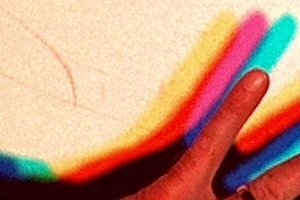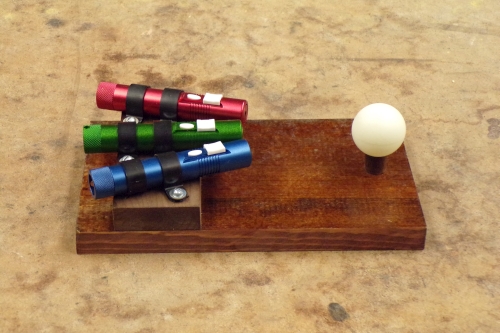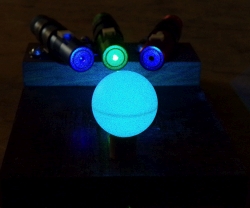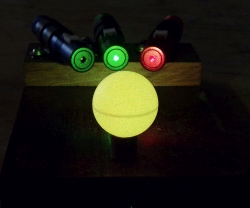
Note: A smaller verion of this demonstration, shown below, is available for use in classrooms outside the Broida lecture hall building.
A red, a green, and a blue bulb shining simultaneously on a screen produce white light. Since the bulbs are displaced from each other along the horizontal axis, placing an object in the light path blocks light from each bulb on a different region of the screen, and thus produces overlapping cyan, magenta and yellow shadows (which, where they overlap, leave shadows of the individual colors, red, green and blue, and, of course, black where all three overlap).
Why?
The human eye sees color by means of three types of cone cells in the retina. These cone cells have pigments whose absorption maxima are at approximately 560 nm (“red”), 530 nm (“green”) and 430 nm (“blue”). I have put these colors in quotes because while they give the relative positions of these absorption maxima within the visible spectrum, they do not necessarily correspond accurately to the colors that we would see for monochromatic light of those wavelengths. They also probably do not correspond to the colors we would see if only one kind of receptor were stimulated, each in turn. For light of a given wavelength or mixture of wavelengths, the color we see depends on the relative responses of the three types of cones. Any combination of lights that stimulates all three types of cone roughly equally appears white. If we shine a red light source, a green light source and a blue light source so that their beams overlap, the region where they overlap appears white. While the colored floodlights on the board in the photograph are not aimed at the same spot, the overlap of their beams is sufficient to illustrate the effect of mixing all three colors to obtain white. We can also observe the mixing of these lights two at a time, as shown in the photographs below.
When you place your hand in front of the screen, for the reason noted above, it casts a set of three overlapping shadows, each one giving the colors shown above. In the photograph at right, we see clearly the yellow shadows where the blue light has been blocked, magenta shadows where green has been blocked, and cyan shadows where red has been blocked. Where pairs of these shadows overlap, they leave red, blue and green, and where they all overlap, of course, we see no color (black). This may be a bit clearer in the inset below:
Because red, green and blue in equal intensities give the sensation of white, and in the appropriate intensity ratios can be made to give the sensation of any desired color, these are called primary colors. More specifically, they are the additive primary colors, because they are colors of emitted light that is stimulating the cones in the retina, and it is their additive effects that produce the various colors.
As noted above, shining any two of these lights is equivalent to subtracting the third from white light, and equal intensities of green and blue together give cyan, red and blue together give magenta, and red and green together give yellow. If you combine pigments of these colors (cyan, magenta and yellow) on white paper in equal portions, cyan and magenta produce blue (white minus red with white minus green leaves blue), magenta and yellow produce red (white minus green with white minus blue leaves red), and cyan and yellow give green (white minus red with white minus blue leaves green). By mixing these pigments in the appropriate proportions, you can produce any desired color. Cyan, magenta and yellow thus constitute a second set of primary colors, specifically the subtractive primary colors.
Devices such as televisions, computer displays and projectors use matrices of red, blue and green light-emitting diodes to produce colored images. Printers use cyan-, magenta-, yellow- and black-colored inks or toners to produce images.
The photograph below shows a smaller version of this demonstration.
This smaller unit has three colored laser pointers, one red, one green and one blue, aimed at a ping pong ball. To turn on one of the lasers, move the rectangular slider over the push-button switch. The photographs below show the unit in operation.
White (All lasers on)
Cyan (White minus red)
Magenta (White minus green)
Yellow (White minus blue)
References:
1) Hubel, David H. Eye, Brain, and Vision. (New York: Scientific American Library, 1988), pp. 162-169.
2) Rossotti, Hazel. Colour — Why the World Isn’t Grey. (Harmondsworth, Middlesex, England: Penguin Books, Ltd., 1983), p. 179.










